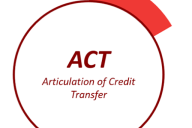You have /5 articles left.
Sign up for a free account or log in.
What really makes a good transfer partnership that benefits students? We have numerous reports and documents outlining what should be done, but mere words are not enough. As Shakespeare wrote in Henry VIII, “Talking isn’t doing. It is a kind of good deed to say well; and yet words are not deeds.” Strong collaboration exhibited through specific actions is what counts when working to make a difference in the student experience.
The information available on transfer highlights the need for strong partnerships and collaboration between two- and four-year institutions. This includes joint marketing, advising, pathway development and student supports that enable students to transition seamlessly from one institution to the next. There are calls for reduced time to completion, acceptance of more credits, financial aid and scholarships to support students as they transfer, and faculty engagement to provide students with on-campus contacts.
In the “Transfer Reset” report, the Tackling Transfer (now Beyond Transfer) Policy Advisory Board called for “Transfer pathways and transitions are streamlined, starting in K-12 and continuing through entry into the workforce, eliminating the ‘transfer maze.’” What actions can partner institutions take to build these types of pathways to benefit students?
In my previous blog post, I reflected on creating a sense of belonging for students, even those in online programs. However, providing this sense of belonging and a strong support system is easier when there are in-person connections and conversations. That is where our University Partnership shines, in the programs that are offered at Lorain County Community College by our four-year partners.
Lorain County’s University Partnership has a long-standing partnership with the University of Toledo in computer science and engineering that models the actions and supports needed for successful student transfer. This partnership has grown over the past 22 years to truly embody the hallmarks of collaboration and student success. Located in the LCCC University Partnership Ridge Campus (UPRC), the program provides students a clear pathway to completing their degrees and entering the workforce. We identified three clear strategies from this partnership that model the behaviors needed for transfer student success.
Student-Centered Services With Assigned Advising, Available Faculty and Clearly Defined Pathways
One of the hallmarks of the partnership between LCCC and Toledo is providing robust student supports from people who have been part of the program for extended periods of time. Toledo provides LCCC partnership students with an assigned, on-site adviser who works from the UPRC location. Toledo’s assigned adviser at UPRC, Adrienne Aguilar, has been with the program since April 2001, since its second semester of existence. She also started as an adviser at LCCC, so she has close connections to both institutions. She dedicates her time and energy to the students from LCCC, providing guided advising and assistance throughout the program and collaborating with the LCCC advising team to assist prospective students. The team of faculty from both LCCC and Toledo who work at UPRC have longevity with a track record of excellent instructions centered on student success. Weng Kang has been with the program since it started, serving in many roles to help the program continue. Others have been with the program for extended periods of time, providing strong support for students in each cohort. Their passion for teaching and dedication to the program strengthens the relationship and impacts student success. In addition, the Toledo team works closely with the LCCC team, including math and science division faculty, advising, financial aid, bursars, and marketing, to ensure students get what they need to complete the program. This teamwork and collaboration have resulted in over 230 students graduating since the program started in 2000. Several graduates have gone on to earn master’s degrees and Ph.D.s through Toledo, Cleveland State University, Ohio State University, Case Western Reserve University, John Hopkins and Harvard University, to name a few.
Consistency of Student Experience Through Cohort Model, Facilities and Location
Students thrive when they know what to expect. Many UP students are older and working to support a family or have other significant time commitments. Providing a consistent schedule of classes allows them to plan ahead as they work to complete their degree. Toledo works with the UP to provide the class schedule well in advance and, with a combination of in-person and distance learning, allowing students flexibility as they move through the program. We also work closely to provide the same courses, laboratory experiences, computer lab access, advising and experiential learning (co-op) opportunities at the UPRC location so students are getting the same education as they would if they went to the Toledo main campus.
Scholarships and Financial Support
Finally, one of the main transfer barriers for students is financing the bachelor’s degree. Many LCCC students experience sticker shock as they transition from a community college to a four-year school. Many are unsure how to make it work without taking out loans. LCCC and Toledo have collaborated on STEM scholarship funding through the state of Ohio’s Choose Ohio First scholarships for these students, providing scholarship dollars that allow students to complete the program.
The LCCC Foundation also offers scholarship assistance to these students totaling almost $2.7 million since 2003. One student said in his scholarship acceptance letter, “The opportunity ahead to earn a four-year undergraduate bachelor’s degree in the field of engineering with costs covered nearly in their entirety was incredibly special.” By providing funding for these students, they are able to stay local, concentrate on their studies without working multiple jobs and stay connected to their cohort to complete the program.
In addition to providing scholarships, the overall structure of the pathway provides students a cost savings of over $40,000 as compared to students who attend Toledo for all four years. Combined with scholarships and the ability to stay local, the overall cost to degree is greatly reduced, which eliminates financial barriers for many students.
Finally, the Toledo program is consistent with LCCC’s earn and learn model. Students in the program are required to complete three semesters of co-op with a local employer as part of their degree. As with students on the Toledo campus, LCCC partnership students complete a professional development course and receive co-op placement assistance from staff in Toledo’s Shah Engineering Career Development Center. Many receive full-time job offers from their co-op employers upon graduation. This allows students the opportunity to work in their chosen field and earn an income while pursuing their bachelor’s degree with Toledo, potentially further defraying the cost of attendance.
LCCC CSE students have been employed by many local companies such as Ridge Tool, LCCC, R. W. Beckett, Hyland, Sherwin-Williams, IBM and NASA Glenn, and even further afield with companies such as the National Security Agency, Intel, the FDA, Expedia, Hewlett-Packard, Disney and Google. Graduates are often offered full-time employment by their co-op company upon degree completion. This aligns well with LCCC’s goal of educating and retaining resident talent to help bolster the local economy. Additionally, many students are able to graduate debt-free or with money in the bank from the advantages of the partnership and its reduced cost of attendance, scholarships and co-op!
By working together to provide clear, consistent and affordable options for LCCC students, this partnership provides a shining example of what is possible for transfer students. The Toledo computer science and engineering program is one of only nine programs in the country, and one of two in Ohio. Students in the program express their appreciation for having access to such a top-notch CSE program close to home.
**Additional information on the partnership can be found here: https://www.lorainccc.edu/up/toledocse/


